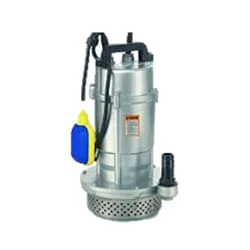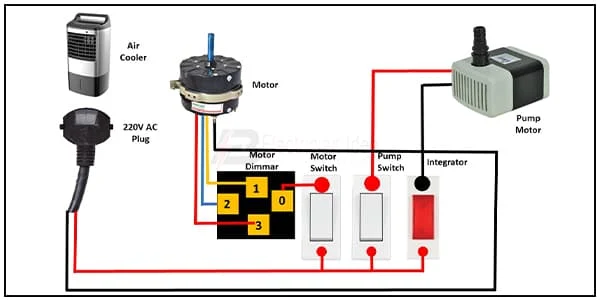Single Phase Air Cooler wiring | air cooler connection
Single Phase Air Cooler wiring:
This diagram shows Air Cooler is a Type of Air Conditioning System That Uses Evaporation to Cool The Temperature of a Set Down. It is a Cost-Effective and Energy-Efficient Option For Cooling dry and Hot Areas. Coolers Pull The Hot, Dry Air and Pass it Through a Wet Wick Inside The Appliance. An Air Cooler is a Home Appliance That Can Cool The air in a Room. The Device Has a Fan That Blows The Warm air From The Surrounding Area Into its Water-Soaked Pad.
Diagram of Single Phase Air Cooler wiring:
Components Need for this Project:
You can get the components from any of the sites below:
- Air Cooler [See Buy Click Amazon]
- Motor [See Buy Click Amazon]
- Pump Motor [See Buy Click Amazon]
- 2-Plug [See Buy Click Amazon]
- Motor Dimmar [See Buy Click Amazon]
- Switch [See Buy Click Amazon]
- Indicator [See Buy Click Amazon]
*Please note: These are affiliate links. I may make a commission if you buy the components through these links. I would appreciate your support in this way!
$ads={1}Read Also:
Components used to make the Single Phase Air Cooler wiring:
01. Air Cooler
 |
| Fig 2: Air Cooler |
Speed air cooler has a fan inside a closed chamber and the air enters through a water-soaked filter inside the chamber. As the air enters through the hood, the moisture in the air is trapped in the hood and the fan inside cools the air to the equivalent of water. So, the air cooler produces the same amount of cold air as water. Air conditioning is a compressor that circulates gas through copper pipe nets to cool the copper pipes, and passing air through the copper pipe nets dehumidifies the air and cools the air in a special way. Air conditioners can be controlled to cool and cool the air.
02. Motor
 |
| Fig 3: Motor |
A DC Motor is a device that Converts Electrical energy into Mechanical Energy. A DC motor usually accepts a DC source and converts it into mechanical energy, hence it is called a DC motor. A motor in which a series field coil is connected to the armature is called a series motor. The torque of a series motor depends on the armature current, and field strength. A motor in which the field coil is connected in parallel with the armature is called a shunt motor. The torque of a shunt motor depends on the variation of mains field strength and armature current.
03. Pump Motor
 |
| Fig 4: Pump Motor |
All kinds of Submersible Pump Suppliers, and Full Global Submersible Pump Technology Support. Well-known submersible Pump manufacturer, global submersible Pump technology support. Sewage Pump. Screw Pump. Water Pump. Fire Pump. Styles: water pump, centrifugal pump, fire pump, sewage pump.All kinds of Submersible pump suppliers, and full global submersible Pump technology support. global submersible Pump technology support, Well-known submersible Pump manufacturer.
04. 2-Plug
 |
| Fig 5: 2-Plug |
Two-Pole Means That the Device Plug is Not Earthed And it Normally Has Two Pins That Transmit Electricity. Originally, all Electrical Devices Were Fitted With 2-Pole Plugs, Which Means That The Devices Were not Earthed and That all Main Sockets were Constructed for 2-Pole Plugs 2-Pin Plugs Consisting of Two flat or Round Pins With one Called “hot”. When Connected to an Electric Circuit, the Current Flows From the live Pins Through the Copper Conductor And into the Device. These Appliances do not Rely on The 'Earth' Wire for Protection From a Short Circuit and Therefore Only 2 Pins are Needed – one for The 'Live' Wire and The Other for The 'Neutral' Wire.
05. Motor Dimmar
 |
| Fig 6: Motor Dimmar |
A Terminal Block Consists of Modular Housing With An Insulated Body That Secures Two Or More Wires Together. Terminal Blocks—Also Referred to as terminal Connectors, Connection Terminals, or Screw Terminals—are Used in a Wide Array of Applications Where Electrical Systems Need to be Safely Connected. Electrical Terminals are a Class of Electrical Connectors That are Used to Transfer Electrical Current From a Power or Grounding Source to use. Terminals "Terminate" by Crimping or Soldering to Wire or Cable.
06. Switch
 |
| Fig 7: Switch |
A Single-Pole, Single-Throw (SPST) Switch. It's Got one Output and One Input. The Switch will Either be Closed or Completely Disconnected. SPSTs are Perfect for on-off Switching. They're also a Very Common Form of Momentary Switches. SPST Switches are Commonly Used in a Variety of Electrical Circuits and Applications, Such as Turning on And off Lights, Fans, and Other Appliances. They can Also be Used to Control the Flow of Electricity to Different Parts of a Circuit or to Switch Between Different Circuits Altogether.
07. Indicator
 |
| Fig 8: Indicator |
An electric current Flow Indicator Senses The electrical Current Through an electrical device And produces visible feedback to Indicate Proper Operation. The Current Flow Indicator Has Voltage And Current Regulation Craving First And Second Inputs Connected To The First And Second Conductors, Respectively. This Publication Provides updated Statistics on a Comprehensive Set of social, Economic, Financial, and Environmental Measures as Well as Select Indicators for Sustainable Development Goals.
Thank You for visiting the website. Keep visiting for more Updates
$ads={2}
Frequently Asked Questions
What are the main components of the air cooler?
the air cooler uses the principle of evaporative cooling to cool the air. There are three main parts to any air cooler – a water tank, an absorbent sheet, or a fan. It works by pulling in hot, dry air and passing it through the wet pad or filter.
What is the internal structure of an air cooler?
the air cooler has three main parts; the water tank, an absorbent sheet, and a fan. You fill the tank with cold water or let the absorbent sheet soak it up. As the water evaporates for the sheet, it cools the air around it. This newly cooled air is blown out into your room by the fan for the natural, refreshing breeze!
What is the best way to use an air cooler?
The best place to the position air cooler is right in front of the window. The hotter the air, the faster the evaporation and the cooler the air blown out by the fan. It's also important to create good ventilation in the room to push the humidity of out. To do this, you need to open the windows in the room.
Which energy is used in the air cooler?
Watt: Most air coolers run on a power supply consumption of 150-300 watts. This means that when an air cooler is operating, it consumes an electrical power supply at a rate of 150 to 300 watts per hour. Kilowatt: The kilowatt (kW) of an air cooler's power supply consumption can be calculated by dividing its wattage by 1000.
How much temperature can the air cooler reduce?
They could reduce the temperature in a single room by 5° to 15°F. Small, portable evaporative coolers on wheels were now available as well. Although the units have the advantage of being portable, their cooling ability is limited by the humidity within our home.









Post a Comment
Do leave your comments